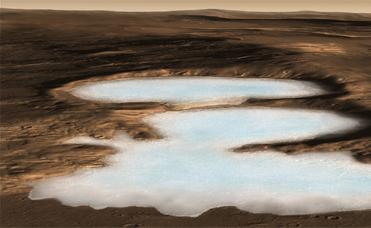
An artist's impression of water-ice glacier on Mars. NASA/JPL photo
WASHINGTON (BNS): For the first time, NASA's Mars Reconnaissance Orbiter has unearthed vast Martian glaciers of water ice under protective blankets of rocky debris at much lower latitudes than any ice previously identified on the Red Planet.
An 11-member team of scientists led by John W Holt of the University of Texas has reported their analysis of the data about buried glaciers in the Hellas Basin region of Mars' southern hemisphere, in the Science journal of November 21.
The buried glaciers extend for dozens of miles from the edges of mountains or cliffs. According to the scientists, a layer of rocky debris blanketing the ice may have preserved the underground glaciers as remnants from an ice sheet that covered middle latitudes during a past ice age. This discovery is similar to massive ice glaciers that have been detected under rocky coverings in Antarctica, they said.
John W Holt, lead author of the report said these glaciers certainly represent the largest reservoir of water ice on Mars that is not in the polar caps. "Just one of the features we examined is three times larger than the city of Los Angeles and up to half a mile thick. And there are many more. In addition to their scientific value, they could be a source of water to support future exploration of Mars".
Scientists have been baffled by what are known as aprons - gently sloping areas containing rocky deposits at the bases of taller geographical features - since NASA's Viking orbiters first observed them on the Martian surface in 1970s.
One theory has been that the aprons are flows of rocky debris lubricated by a small amount of ice. Now, the shallow radar instrument on the Mars Reconnaissance Orbiter has provided scientists an answer to this Martian puzzle, they said.
"These results are the smoking gun pointing to the presence of large amounts of water ice at these latitudes," said Ali Safaeinili, a shallow radar instruments team member with NASA's Jet Propulsion Laboratory in Pasadena, California.
According to NASA, radar echoes received by the spacecraft indicate that radio waves pass through the aprons and reflect off a deeper surface below without significant loss in strength. That is expected if the apron areas are composed of thick ice under a relatively thin covering. The radar does not detect reflections from the interior of these deposits as would occur if they contained significant rock debris. The apparent velocity of radio waves passing through the apron is consistent with a composition of water ice.
Scientists developed the shallow radar instrument for the orbiter to examine these mid-latitude geographical features and layered deposits at the Martian poles. provided the instrument.
Leader of the instrument science team at the University of Rome La Sapienza in Italy, Roberto Seu, said the instrument was developed for this kind of terrain. "It is now a priority to observe other examples of these aprons to determine whether they are also ice," he said.
"There's an even larger volume of water ice in the northern deposits," said JPL geologist Jeffrey J Plaut, who will publish results about these deposits in the American Geophysical Union's Geophysical Research Letters.
"The fact (that) these features are in the same latitude bands, about 35 to 60 degrees in both hemispheres, points to a climate-driven mechanism for explaining how they got there," he said.
The scientists said the rocky debris blanket topping the glaciers apparently has protected the ice from vapourising, which would happen if it were exposed to the atmosphere at these latitudes.
James W Head of Brown University in Providence, R.I., said an important question troubling all is, ‘how did the ice get there in the first place?’ "The tilt of Mars' spin axis sometimes gets much greater than it is now. Climate modeling tells us ice sheets could cover mid-latitude regions of Mars during those high-tilt periods. The buried glaciers make sense as preserved fragments from an ice age millions of years ago. On Earth, such buried glacial ice in Antarctica preserves the record of traces of ancient organisms and past climate history”.
 Previous Article
Previous Article Next Article
Next Article













The Indian Air Force, in its flight trials evaluation report submitted before the Defence Ministry l..
view articleAn insight into the Medium Multi-Role Combat Aircraft competition...
view articleSky enthusiasts can now spot the International Space Station (ISS) commanded by Indian-American astr..
view article